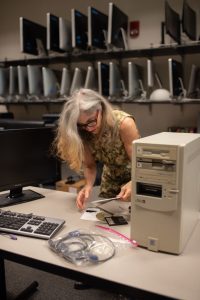 As we have often stressed in our blog posts, the Electronic Literature Lab needs hardware and software in order to access the born-digital art, literature, and games we are collecting and making accessible via documentation and exhibitions. We emulate works when needed, but we prefer to encounter them on their original platform so as to provide a better understanding of them.
As we have often stressed in our blog posts, the Electronic Literature Lab needs hardware and software in order to access the born-digital art, literature, and games we are collecting and making accessible via documentation and exhibitions. We emulate works when needed, but we prefer to encounter them on their original platform so as to provide a better understanding of them.
To do this, we have accumulated over 80 computers covering various different operating systems and hardware affordances. In this way we can access Talan Memmott’s net art piece, “Lexia to Perplexia” (2000), which requires the extensions offered by Internet Explorer 4.5, on the System Software 9.2.2 afforded by our Power Mac G4 Tower running Mac OSX 10.4.6 or the CD-ROM holding Nancy Buchanan’s “developing: the idea of a home” (1999) on the iMac G4 Flat Panel running Mac OSX 10.3.9.
For years we have had a gap in our hardware collection––a PC with a 5.25-inch disk drive––to access Timothy Leary’s Mind Mirror (1986). The Internet Archive has published a version accessible on Apple II, Atari 8-bit, and Commodore 64 (See: https://archive.org/details/msdos_Timothy_Learys_Mind_Mirror_1986), but we own a PC version of it. Also, we have copies of the game Amnesia (1986), for the Apple IIe / Commodore and the IBM and have never been able to compare the two versions since we do have access to a PC that could run that version of the game.
Enter the BBC article that came out in May 2025 (See: https://www.bbc.com/future/article/20250516-the-people-stuck-using-ancient-windows-computers) where readers learned that we needed this particular computer. Over 130 people reached out to us. Since then we have received several PCs, 5.25-inch floppy disks, manuals, a Quest 2 headset, games and other much needed resources for undertaking our research.
And so, this post introduces our new series, “Retro Computing,” where we highlight our friends who have supported us in our endeavor to build our retro hardware and software library.
